For all the lyrical ghost stories, mutant amphibians, and kaiju-inspired aspects of the outer-gods, and mystically empowered Nazis, the Hellboy universe has rarely touched the realm of extraterrestrials. That all changes, however, with the new miniseries The Visitor: How and Why He Stayed, which explores the life and of an alien, one of several briefly glimpsed in “Seeds of Destruction,” from his arrival at the time of Hellboy’s birth all the way to his death in “The Conqueror Worm.”
The first issue, written by Chris Roberson and Mike Mignola with art by Paul Grist, released Wednesday, fits neatly into Hellboy’s earliest days, as well as some of the earliest of Mignola’s stories on the character and features a number of references and allusions to classic stories that will have readers, this one included, going back through nearly-20-year-old comics to see how everything connects. With the issue’s release, we talked to longtime Dark Horse editor and Abe Sapien writer Scott Allie about a story two decades in the making.
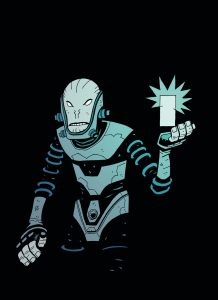
How long had plans for The Visitor been gestating? Was the alien’s story set since his death in “The Conqueror Worm?”
Chris pitched this after we’d gotten rolling with him. Witchfinder was the first thing he wrote for us—well, first I’d brought him in on Aliens: Fire and Stone, and loved what he did there, so I asked him to pitch for both Serenity and Witchfinder. Both those books were without writers, and I wanted to do more sooner than later. I hired him for both. The Witchfinder pitch was so good, and then the scripts were so good, we invited him to do more stuff.
This happened to be right around the time [John] Arcudi had told me he’d be leaving after the end of Hell on Earth and Hellboy & the BPRD 1952. So I asked Chris to pitch for 1953, and that sort of placed his focus on the older parts of the Hellboy world. The Visitor was the third thing he’d pitched us, and we loved it. His pitches for Witchfinder and 1953 gave us what we wanted, but The Visitor gave us something we hadn’t known we wanted, something we would not have come up with on our own.
We’d never planned to do this, but as soon as he threw the idea at us, we jumped at it. The way he expressed it, in just a few words, the reference points he gave us for the kind of story he wanted to do—we were sold. It was a chance to do a very different kind of book, and we’ve gotten just what we were hoping for from Chris and Paul.
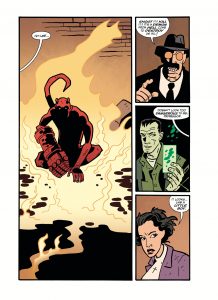
The great thing about how Mike [Mignola] has built this world, and how the other writers have added to it, is that no, the Visitor’s story was not set at the time that Mike did “Conqueror Worm.” Parts of it were, but Mike only ever shows you as much as he needs to to make the story work. So “Conqueror Worm” worked very well as it was, but there was a lot of room to interpret what had gone on with the Visitor himself over the years.
Why tell this story now, after both the end of Hellboy’s story in Hellboy in Hell and the end of BPRD: Hell on Earth?
Partly it was simply getting the pitch we liked, but on a deeper level, as things close in on the world around our characters, it’s a good time to reveal a bit more of how things got to be the way they are.
In BPRD, the Ogdru Hem, after almost ending the world, are now dead, the threat ended with the death of the Ogdru Jahad on Earth. So with that story told, this was a chance to look back at how that threat had risen over a very long period of time, and who else had been trying to deal with the threat.
In working out this story, it offered us a chance to talk through a lot of the bigger repercussions of this guy’s presence on Earth, and his friends away from Earth. I mean talk about it between Chris and Mike and me, and it led us to explore ideas into which we may or may not dig more deeply.
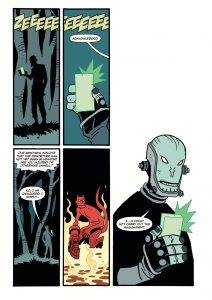
Was there any concern among creators or the editorial team that revealing more about Hellboy’s protector would undercut his competency or heroism?
No, that’s not the sort of thing we think much about. Hellboy’s not meant to be Superman. He’s not perfect, and the idea that he maybe had help or a guardian angel doesn’t make him any less Hellboy.
The first issue of The Visitor is loaded with references to other Hellboy stories, going back to some of the earliest stories to as recent as Hellboy and the BPRD 1953. Were there any concerns about losing readers with this many obscure references?
Yeah, this is something we do think about. We always try to strike a balance. Hopefully you can pick up any book and get a lot out of it, understand it, enjoy it and the more you know about the world, the more you are able to immediately recall, the more you get out of it.
But throughout the series, there are flashes to moments that’ll be familiar to long time readers, and moments that are not; hopefully they all work in the context of this story. For the reader who isn’t well versed, all those moments will be new, and they should resonate enough to tell the story. But this is also a peculiar type of story, so if some moments are particularly oblique, that’s sort of the point.
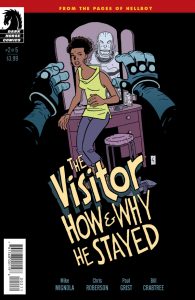
Going back to stories like “The Nature of the Beast,” that was referenced in The Visitor #1, it’s interesting to see how well the stories mesh up. Had Mike Mignola communicated how the alien would fit into these moments that might have read like plot holes to readers 15 years ago?
Did that seem like a plot hole when you read it? I guess I can see that, but I doubt it really did. But now you just understand it a bit more—more than Hellboy himself ever will.
Magic is so alive in Hellboy’s world, and things happen for all sorts of reasons, that I think readers accept those things. The bit from “Nature of the Beast” was certainly the bit I was most concerned about in issue #1, making sure that worked for new and old readers alike.
There were a lot of conversations about this stuff. When this sort of collaboration is working, you don’t remember who said what, what came from whom… there was this one great lunch in Portland when Mike was visiting—we’d already resolved to do The Visitor, but Chris was still in early stages of scripting. We talked about The Visitor, we talked about other stuff that’s already come out since, and we talked about things that are still real far down the line.
We talked about specific moments, and how they’d work in this miniseries, but it was much more back and forth between us than Mike spelling it out. He’s really a great and generous collaborator. When he has a specific idea about one of his things, then yeah, we try to get it that way—but he’s very open to others’ ideas. That’s how we’ve built the world around these books that we have.
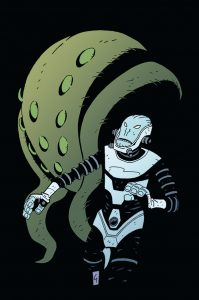
It’s interesting to see Paul Grist’s more cartoonish take on some of Mike’s older stories in The Visitor #1. How did Grist get involved with the project?
I’m pretty sure Paul was Chris’s suggestion, and Mike and I jumped at it. And as usual Mike assumed we wouldn’t be able to get him. “He’s not gonna want to work on my stuff.” We knew we wanted a different tone to this book but I think initially Mike and I were probably thinking of our go-to guys. Then Chris suggested Paul and it all came into focus.
We wanted this to be a Paul Grist comic, so we asked him to pick the colorist, and he brought in Bill Crabtree. We asked him to design the logo. Mike did a variant cover, but the trade cover will be Grist, because it has to be. Even Chris is sort of bowing to Paul in that he’s writing the book a bit differently than normal, in part to get the tone he wants out of the story, in part to match Paul’s tone. Which is all one and the same.
Many of the recent Hellboy miniseries have been exploring the time in between 1945 and “Seed of Destruction.” What other minor characters would you like to follow or times you’d liked to see explored in between Hellboy’s birth and the first major story?
We need Gabriel Ba and Fabio Moon to finish the story of Simon Anders [from BPRD 1947 and BPRD Vampire]. That’s an important one. We’ll see more of Bruttenholm, explore his story more. But that, like a lot of what remains to be told, will happen mainly in the pages of Hellboy & the BPRD, which will continue to breeze through the years tracking the BPRD and all the people who come in and out of it. There are some World Ware II-era villains that were hinted at in Guy Davis’s run on BPRD that we could still dig into a bit more.
![]()